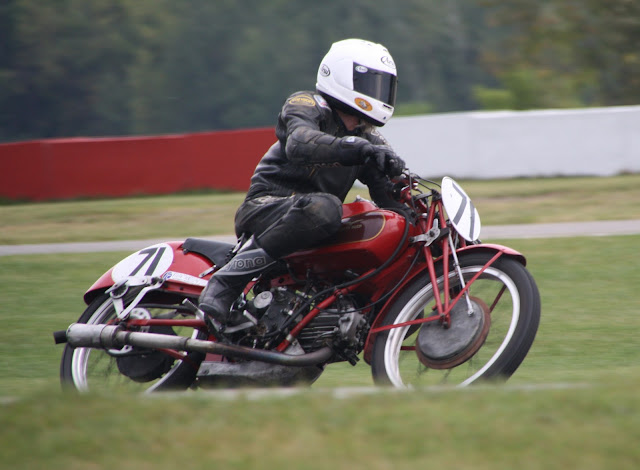 |
| Doog with the 1938 NSU 500 he had just bought |
 |
| an impressive OHC motor |
This is a bike that Rene bought new in '86, rode a couple of days on the street to break it in, then started racing it. He raced it for several years but, when his twin daughters were born (both motocrossers now), he put the racing aside for a while and his brother Claude took the bike over and put it back on the street. After a couple of years, Claude got the racing itch and put it back to race trim.
 |
| Joe Bar Team '86 RZ350 |
Practice went well Sat. am. The Dondolino still had the high rpm misfire that had started at Mosport, despite cleaning the slipring and changing the carbon pick-up in the magneto, but seemed to be happy with short shifting.
 |
| Vickie Fournier Photo |
 |
| Vickie Fournier photo |
 |
| Vickie Fournier photo |
 |
| Vickie Fournier photo |
Once again, I was the only Pre-50 entry and I was gridded behind P-1 Open and P-1 350. There were 17 entries overall and I ended up 7th behind 3 Open and 3 350 bikes.
 |
| Vickie Fournier photo |
 |
| Vickie Fournier Photo |
Sun. morning, I went to start the Dondolino and it popped a couple of times, then nothing. We tried pushing it a couple of times, but nothing. I put it on some starting rollers, but nothing; no spark. I took the RZ out in the fast practice and it was working great. Rene tells me the motor is stock except for the reed valves and the exhaust pipes and the chassis is stock except for an Ohlins rear shock. I was well impressed by the Heidenau tires and the gearing was perfect, shifting up just under 10,000 rpm.
I futzed with the Dondo magneto cleaning and setting the points and checking the timing, but still no spark. I went out again on the RZ, and on the 3rd lap, accidentally downshifted twice instead of once going into turn #1, and revved the engine really high. After that, it went flat and I pull off at the end of the lap. It wasn't firing on the right side and when Rene pulled the sparkplug, we found it bridged with a ball of something. But, the ball seemed to be just carbon, as it just crumbled. We put the plug back in, and it fired on both sides, but was backfiring on the right. So, Rene put in a new plug: same thing, backfiring on the right. Then suddenly, it wouldn't fire at all: no spark on either side. As my race was the first of the day, all we had time for was to try a different coil, but it made no difference. My theory is that when I over revved it, the ignition rotor may have come apart.
So, the Spark Gods abandoned me Sunday and I didn't get to start either race. Some days are like that and it always could be worse.
Rene and Claude are part of Joe Bar Team, named after a French motorcycle cartoon similar to the British Ogri. In addition to Rene and Claude is their young niece Vickie, races a European market NSR 250 street bike(Vtwin, two stroke), and a couple of other fellows with a RS 125 and an FZR 400. Joe Bar team is a wonderful crowd with a great sense of humor, as evidenced by the fuel tank on the RZ.
I packed up early and went to say goodbye to Joe Bar Team just as Claude and Vickie were going out for the P-4 F-1 race, Claude bumping up from F-2 and Vickie from F-3. So, I went up in the grandstands with Rene and his wife and the remainder of Joe Bar Team. Claude got a good start but, this being the fastest class, started losing ground. Vickie however, was gaining ground and, as the race wound down, one had to wonder if she could catch Claude. Sure enough, she pulled along side him in the last corner and got the better drive, just pipping Claude at the line, much to the delight of the rest of Joe Bar Team.
Last year, having not been to Quebec for several years, I was impressed with how well the Francophones and Anglophones seem to get along. This year, having heard of the narrow victory of the separatist party and the subsequent shooting by the disgruntled Anglophone just before I left for Quebec, I wondered if the atmosphere would be more tense. Not at all, at least in the racing community. On the contrary, if anything the atmosphere was more friendly and co-operative and I had a great time despite the disappointment of not racing Sunday.





















